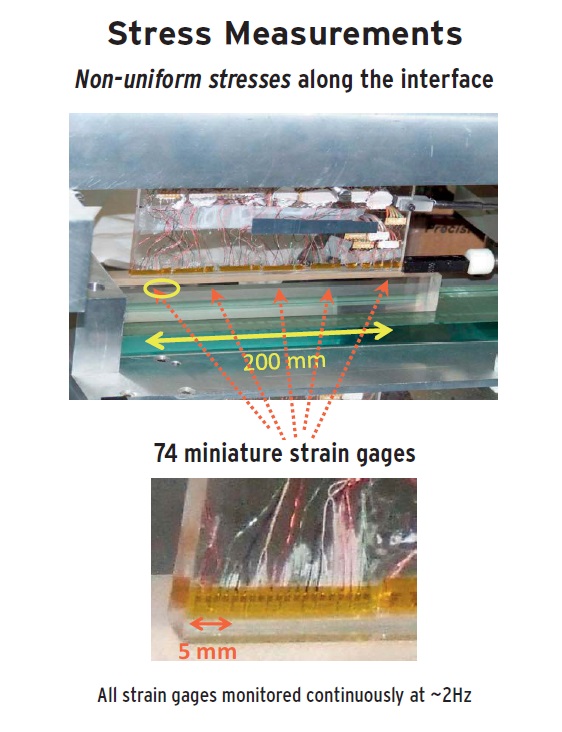Origin of dry friction
Dr. Neil Canter, Contributing Editor | TLT Tech Beat October 2014
New research shows direct relationship between dry friction and fracture.
KEY CONCEPTS
•
Dry friction involves the interaction between two dry interfaces such as a block on a table.
•
A new study shows that dry friction occurs once contacts between surfaces are ruptured and establishes a direct relationship between dry friction and fracture.
•
This work may help to better understand how to predict the origin and magnitude of earthquakes.
FRICTION REMAINS ONE OF THE KEY PARAMETERS that needs to be better understood to facilitate the development and use of better lubricants. Recent research has closely examined the work being done to better understand how friction exist at the nanoscale between molecules.
In a previous TLT article, a new type of friction known as desorption stick was described (
1). Researchers used an atomic force microscope to measure the frictional forces detected when a polymer molecule (polystyrene is one example) is pulled up in a perpendicular fashion from a surface such as diamond. Desorption stick is a frictional force that holds a polymer chain in the lateral direction on the surface.
On the macroscale level, the main type of friction discussed is fluid friction where a solid is in contact with a fluid that is a lubricant. But there is also a type of friction known as dry friction, which is present when two dry surfaces are placed in contact with each other.
Jay Fineberg, professor of physics at the Hebrew University of Jerusalem’s Racah Institute of Physics in Jerusalem, Israel, says, “Dry friction is exactly as the term is written. It involves the interaction between two dry interfaces such as a block on a table. There are no lubricants involved in this process. The contact between the surfaces is not that different from fluid friction, which involves the use of a large amount of lubricant.”
One other phenomenon that is continually under study is the mechanism for the formation of cracks or fractures in materials. This is particularly important as it can be a leading cause of machinery failure due, in part, to inadequate lubrication. A previous TLT article described large-scale computer simulations done to show that cracks propagate through materials in a helical fashion (
2).
Dry friction and fracture both occur in earthquakes, which take place due to the release of energy as dry moving rocks within the earth collide with each other. But there has been thought that originated over 500 years ago from work done by Leonardo da Vinci that these two phenomena are not related.
New research now indicates that dry friction and fracture are, in fact, dependent upon each other. This work now shows that the onset of dry friction cannot occur until the surfaces interacting with each other become fractured.
LABORATORY EARTHQUAKES
Fineberg and his associate, Ilya Svetlizky, have determined through a series of experiments that there is a direct relationship between dry friction and fracture. He says, “We found that by simulating earthquakes in the laboratory that dry frictional motion between two surfaces takes place once contacts between the surfaces are ruptured.”
The earthquakes were generated by pressing together two solid, flat blocks prepared from the plastic, poly methyl methacrylate. An externally applied normal force of 5,500 Newtons was used to force the blocks together. Fineberg says, “The reason we used poly methyl methacrylate was that we needed a brittle, transparent material to ensure that there was uniform contact along the interfaces.”
Once the two blocks formed an interface, fractures were generated along the interface at the speed of sound and in some cases, according to Fineberg, at supersonic speeds. Miniature strain gauges were used to measure the rupture along the interfaces.
Figure 2 shows how the 74 miniature strain gages were positioned in the experimental setup.
 Figure 2. Miniature strain gages were used to measure the rupture generated when earthquakes were simulated in the laboratory as a way to study the relationship between dry friction and fracture. (Photo courtesy of the Hebrew University of Jerusalem)
Figure 2. Miniature strain gages were used to measure the rupture generated when earthquakes were simulated in the laboratory as a way to study the relationship between dry friction and fracture. (Photo courtesy of the Hebrew University of Jerusalem)
Frictional interfaces detected by the researchers were very weak but present. Fineberg says, “The empirical results we obtained fit the theoretical data developed by linear elastic fracture mechanics (LEFM) very well.”
The relationship between dry friction and fracture has implications for predicting the origin and magnitude of earthquakes. The same types of interactions between rough, flat dry surfaces conducted in Fineberg’s laboratory are also seen in the earth.
Fineberg says, “Earthquakes can be produced tens to hundreds of kilometers below the earth and the only current way to measure their dynamics is by means of triangulation through acoustics. Our work suggests that strain meters can be placed below the earth’s surface to measure the fracture energy produced from each earthquake. Data produced may help to better understand the relationship between fracture energy and earthquake intensity.”
Future work for Fineberg will involve gaining a better understanding of earthquakes. He says, “We would like to determine what earthquakes do, how they function and how the velocity they produce creates such significant damage.”
Fineberg also will be applying a lubricant to the interface formed in the laboratory earthquake experiments. He says, “The introduction of a lubricant to the interface formed between the two blocks may provide more information about how the impact of the blocks is related to the friction.”
Additional information can be found in a recent article (
3) or by contacting Fineberg at
jay@mail.huji.ac.il.
REFERENCES
1.
Canter, N. (2013), “New type of friction observed at the nanoscale,” TLT,
69 (8), pp. 10-11.
2.
Canter. N. (2010, “Crack formation in 3D,” TLT,
66 (7), pp. 8-9.
3.
Svetlizky, I. and Fineberg, J., “Classical shear cracks drive the onset of dry frictional motion,”
Nature,
509 (7499), pp. 205-208.
 Neil Canter heads his own consulting company, Chemical Solutions, in Willow Grove, Pa. Ideas for Tech Beat items can be sent to him at neilcanter@comcast.net
Neil Canter heads his own consulting company, Chemical Solutions, in Willow Grove, Pa. Ideas for Tech Beat items can be sent to him at neilcanter@comcast.net.